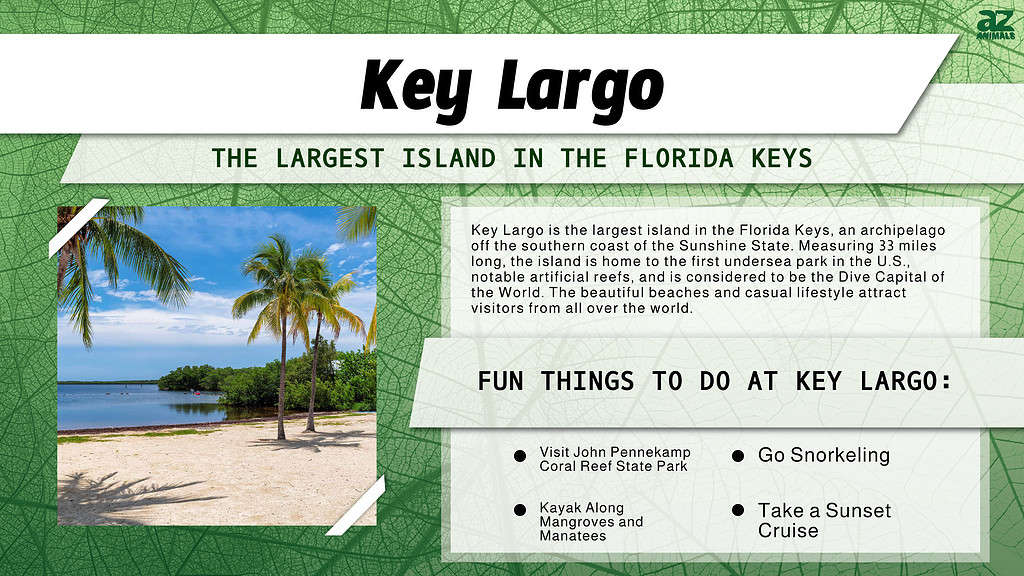
The United States is filled with many extraordinary natural parks with jaw-dropping landscapes and unique wildlife of all kinds. But did you know that the U.S. also has a hidden state park off the largest island in the Florida Keys — and it’s underwater? That’s right, folks, you can actually visit an UNDERWATER state park! How cool is that? There is plenty to see and do, so let’s get right to it and discover John Pennekamp Coral Reef State Park!
The First Underwater Park in the United States
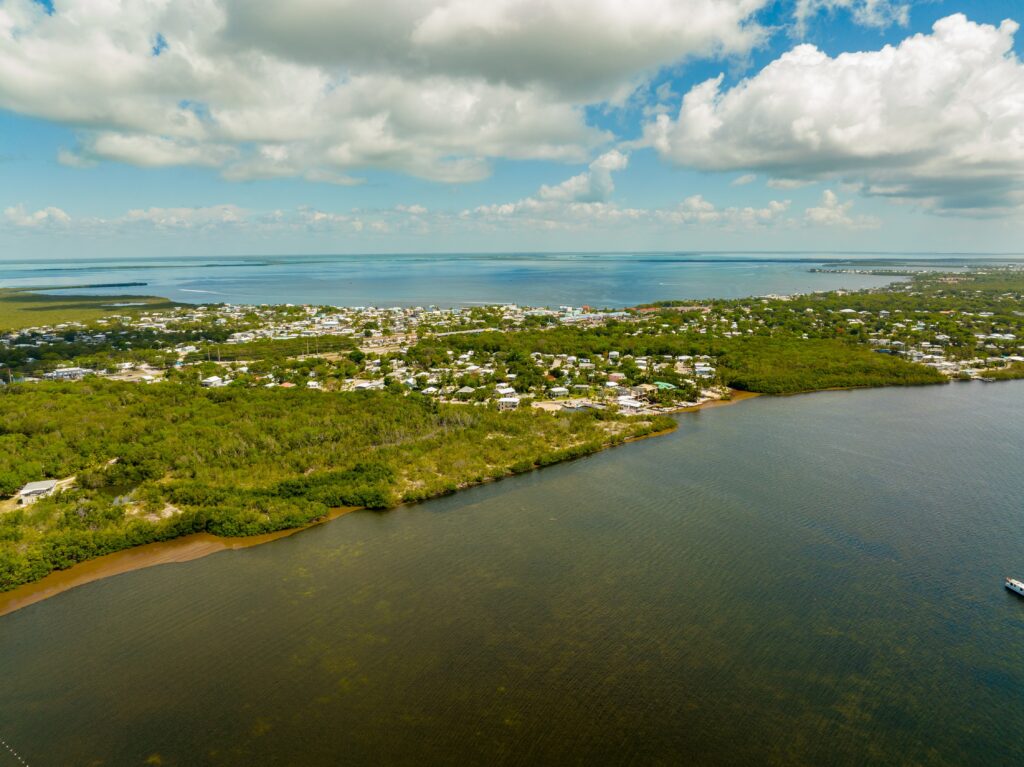
The John Pennekamp Coral Reef State Park includes 3 miles of the Atlantic Ocean.
©Felix Mizioznikov/Shutterstock.com
Off the coast of Florida are over 200 small islands known as the Florida Keys. This unique archipelago is also the home of the only living coral reef in the continental U.S. It is the third largest coral reef in the entire world! Unfortunately, as people visited these beautiful islands from the 1900s to the 1950s, the reefs experienced great damage. Tourists and tourism companies frequently chiseled out corals from the coral reef, along with seashells, sponges, and even seahorses, to sell and take home as souvenirs. Sometimes they even used dynamite! The coral reefs in the Florida Keys took thousands of years to form, and yet over just a few decades, they were disappearing at an alarming rate.
Fortunately, John Pennekamp, an editor with the Miami Herald, fought to legally protect these beautiful underwater ecosystems. Finally, in 1963, President Dwight D. Eisenhower designated a section of Key Largo — the largest island in the Florida Keys — as the Key Largo Coral Reef Preserve. Later, the governor of Florida changed the name to John Pennekamp Coral Reef State Park to honor Pennekamp’s role in protecting the reef here. Today Key Largo claims the title of the “Diving Capital of the World” due to these beautiful coral reefs.
Where is Florida’s Hidden State Park on a Map?
Florida’s hidden state park is located off the coast of Key Largo, the largest island in the Florida Keys. The Keys are an archipelago of 200 islands that stretch from the southernmost tip of Florida south toward Cuba.
John Pennekamp Coral Reef State Park at Key Largo
Key Largo is the largest island in the Florida Keys, measuring 33 miles long. John Pennekamp Coral Reef State Park encompasses part of the island on land and the ocean beyond it. The park boasts large mangrove swamps and lush tropical hammocks along 25 miles of stunning coastline and reaches 3 miles into the Atlantic Ocean.
The marine sanctuary spans up to 70 nautical square miles of ocean. Closer to the coast, the water is shallow and averages a depth of just 5 to 15 feet. However, scuba tours can reach further out and venture into depths around 30 to 45 feet.
Plant Life at John Pennekamp Coral Reef State Park

The John Pennekamp Coral Reef State Park features several pockets of mangrove trees.
©Sean Lema/Shutterstock.com
Along the coast of Key Largo, you can explore many coastal berms. These storm-deposited ridges of sediment are made up of different things like shell fragments and pieces of coralline algae. They range from 1 to 10 feet tall and offer an up-close look at a variety of tropical plants and trees. You can find tall shrubs and short trees like the Spanish stopper, saffron plum, hog plum, and white indigo berry here. Short shrubs and herbs such as spider lilies, rouge berries, and limber caper also grow on these coastal berms. You might also come across mangrove trees, joewood, buttonwood, and sea ox-eye daisy near the seashore.
Here is a quick list of just some of the plants that often grow on the coastal berms of John Pennekamp Coral Reef State Park:
- Gumbo limbo (Bursera simaruba)
- Hog plum (Ximenia americana)
- White indigo berry (Randia aculeata)
- Spider lily (Hymenocallis latifolia)
- Poisonwood (Metopium toxiferum)
- Lantana (Lantana involucrata)
- Spanish stopper (Eugenia foetida)
- Saffron plum (Sideroxylon salicifolium)
- Limber caper (Cynophalla flexuosa)
- Sea purslane (Sesuvium portulastrum)
- False mint (Dicliptera sexangularis)
- Cordgrass (Spartina spp.)
- Seashore dropseed (Paspalum spp.)
- Buttonwood (Conocarpus erectus)
- Red mangrove (Rhizophora mangle)
- White mangrove (Laguncularia racemosa)
- Black mangrove (Avicennia germinans)
- Inkwood (Exothea paniculata)
- Sea ox-eye daisy (Borrichia arborescens)
Marine Life at John Pennekamp Coral Reef State Park
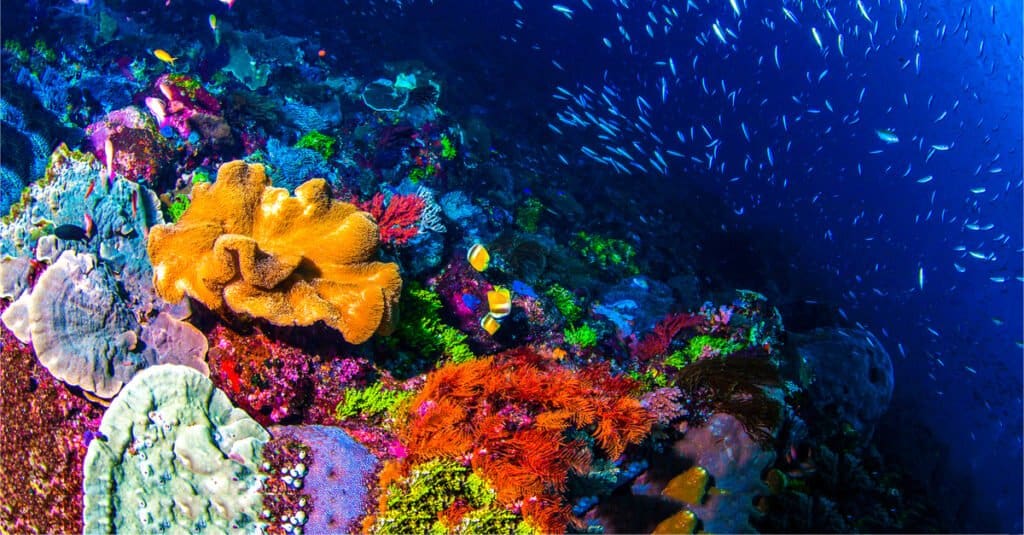
True to its name, a variety of corals are found in the John Pennekamp Coral Reef State Park.
©Irina Markova/Shutterstock.com
John Pennekamp Coral Reef State Park is a protected paradise for all kinds of marine life. The reefs here are communities of hard and soft corals living in shallow stretches of water. The clear, warm water here gives these animals a place to thrive and grow.
Corals are surprisingly small animals, with some that can be as small as the head of a pin! But don’t let their tiny size fool you — some colonies of corals can reach sizes larger than a house! However, corals take a very long time to grow — the coral reefs at John Pennekamp took thousands of years to grow into what we see today! Brain corals, for example, grow around just 0.25 to 0.5 inches yearly, while staghorn coral grows about 1.5 inches yearly. However, staghorn corals are much more delicate, and if you even just touch their outer layers, you can easily injure or even kill them!
Fortunately, in addition to John Pennekamp Coral Reef State Park, most of the reefs of Key Largo are also protected as part of the Florida Keys National Marine Sanctuary. This protection has significantly increased the health and populations of marine life here while still allowing careful eco-tourism activities.
So, what types of marine life can you see at John Pennekamp Coral Reef State Park? Let’s take a closer look!
Corals
There are 80 different species of coral that live in the waters of John Pennekamp Coral Reef State Park. Elkhorn coral, for example, grows long branch-like sections that provide homes for many other animals living in the reef. A single colony can be as tall as 6 feet and as wide as 12 feet! However, elkhorn and several other coral species here are endangered, so protecting the park’s biodiversity is important.
Brain coral is another common species in the park, and like its name, it looks somewhat like a spongy brain. On the other hand, sea fans have a much more delicate appearance, with small branches that link together to form beautiful latticework planes.
Here are just a few examples of some of the coral species that live in John Pennekamp Coral Reef State Park:
- Elkhorn coral (Acropora palmata)
- Staghorn coral (Acropora cervicornis)
- Blushing star coral (Stephanocoenia intersepta)
- Brain coral (Diplora sp. and Pseudodiploria spp.)
- Star coral (Siderastrea siderea, Montastraea sp., and Orbicella spp.)
- Starlet coral (Siderastrea siderea)
- Lobed star coral (Solenastrea hyades)
- Knobby cactus coral (Mycetophyllia aliciae)
- Starlet coral (Siderastrea radians)
- Smooth star coral (Solenastrea bournoni)
- Sea whips (Pterogorgia spp.)
- Sea rods (Plexaura spp.)
- Fire coral (Millepora spp.)
- Mustard hill coral (Porites astreoides)
- Lettuce coral (Undaria agaricites)
- Smooth flower coral (Eusmilia fastigiata)
- Tube coral (Oculina spp.)
Invertebrates
In addition to the colorful corals living in John Pennekamp Coral Reef State Park, there are also many other unique and fascinating types of invertebrate animals. Sea cucumbers live on most of the reefs here, although they are excellent at hiding, so they can be hard to spot. On the other hand, sea urchins are much easier to see at the park. These remarkable sea creatures are covered with hundreds of hard spikes that protect them against predators. Brittle stars are shy and like to hide, but sometimes you can find them if you look carefully under ledges and at the mouth of tube sponges. Brittle stars come in just about every color of the rainbow and have bioluminescent hairs on their legs that glow in the dark!
Here are a few more examples of some of the fascinating invertebrates that you might come across at John Pennekamp Coral Reef State Park:
- Caribbean long-spined urchin (Diadema antillarians)
- Decorator crab (Microphrys bicornuta)
- Common blue crab (Callinectes sapidus)
- Spiny lobster (Panulirus argus)
- Banded coral shrimp (Stenopus hispidus)
- Thorny starfish (Echinaster sentus)
- Florida sea cucumber (Holothuria floridana)
- Christmas tree worm (Spirobranchus giganteus)
- Cushion sea star (Oreaster reticulata)
- Milk conch (Strombus costatus)
- West Indian sea egg (Tripneustes ventricosus)
- Caribbean reef squid (Sepioteuthis sepioidea)
Fish
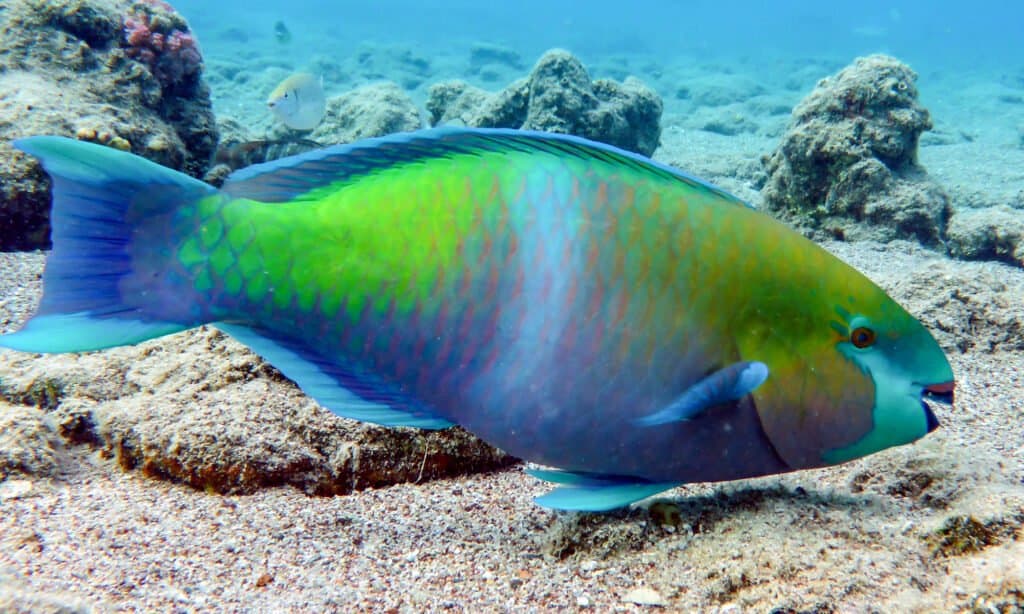
There are 15 species of parrotfish at the John Pennekamp Coral Reef State Park.
©FromMyEyes/Shutterstock.com
John Pennekamp Coral Reef State Park is home to over 260 different species of tropical fish, with hundreds of different colors. For example, the males and females of many of the 15 species of parrotfish at the park are different colors. Sometimes the juvenile fish are a separate color as well, so just among parrotfish, there could potentially be around 50 different color patterns!
If you come across what looks like a “mini” parrotfish, it’s likely a wrasse. Groups of wrasses often gather at “cleaning stations” to help pick off dead skin and parasites from larger fish. In addition, you can always count on seeing a damselfish at the park. These small fish are harmless but extremely territorial. If you get too close to their algae garden patches, they will attack and try to scare you away — although they often look more like they are dancing than attacking.
- Sergeant major (Abudefduf saxatilis)
- Queen triggerfish (Balistes vetula)
- Porcupinefish (Diodon hystrix)
- Blue runner (Caranx crysos)
- Nassau grouper (Epinephelus striatus)
- Queen angelfish (Holacanthus ciliaris)
- Black grouper (Mycteroperca bonaci)
- Ocean surgeonfish (Ocean surgeonfish)
- Porkfish (Anisotremus virginicus)
- Peacock flounder (Bothus lunatus)
- Foureye butterflyfish (Chaetodon capistratus)
- Rainbow parrotfish (Scarus guacamaia)
- Yellowhead wrasse (Halichoeres garnoti)
- Shortfin pipefish (Cosmocampus elucens)
- Scrawled filefish (Aluterus scriptus)
- Bluelip parrotfish (Cryptotomus roseus)
Larger Marine Animals
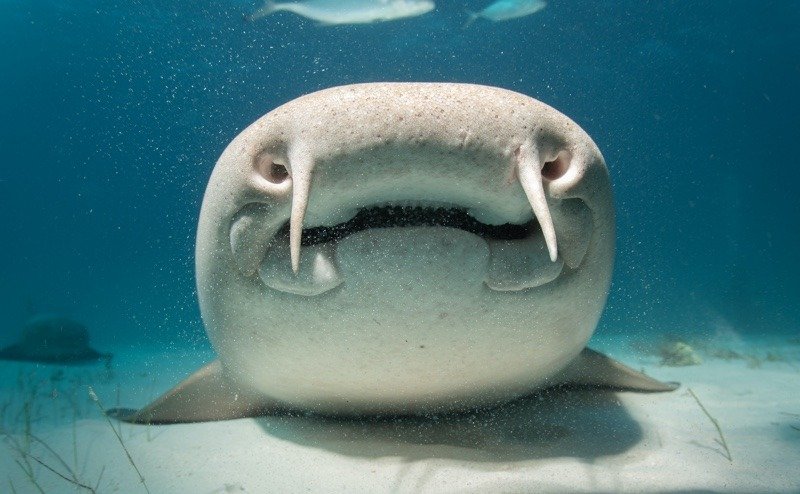
Nurse sharks
, which aren’t aggressive, are the most common sharks at the John Pennekamp Coral Reef State Park.
©Maui Topical Images/Shutterstock.com
If you go diving in John Pennekamp Coral Reef State Park, you’ll also have the opportunity to see much larger sea creatures. Sea turtles are common here, particularly the hawksbill sea turtle (Eretmochelys imbricata).
There are also sharks at the park, but the most common one you’ll see is a nurse shark — which is not aggressive toward humans. You might even see some gentle manatees grazing in the water if you kayak near the mangroves and seagrass beds. There are also stingrays, jellyfish, barracudas, and even crocodiles, although they are not as common.
Here are a few examples of some of the larger marine animals you might see at John Pennekamp Coral Reef State Park:
- Spotted eagle ray (Aetobatus narinari)
- Southern stingray (Dasyatis americana)
- Yellow stingray (Urolophus jamaicensis)
- Tiger shark (Galeocerdo cuvier)
- Lemon shark (Negaprion brevirostri)
- Bonnethead shark (Sphyrna tiburo)
- Reef shark (Carcharhinus perez)
- Hawksbill turtle (Eretmochelys imbricata)
- Loggerhead turtle (Caretta caretta)
- Green turtle (Chelonia mydas)
- Bottlenose dolphin (Tursiops truncatus)
- Florida manatee (Trichechus manatus latirostris)
- American crocodile (Crocodyluc acutus)
- Eastern indigo snake (Drymarchon corais cooperi)
Things to Do at John Pennekamp Coral Reef State Park
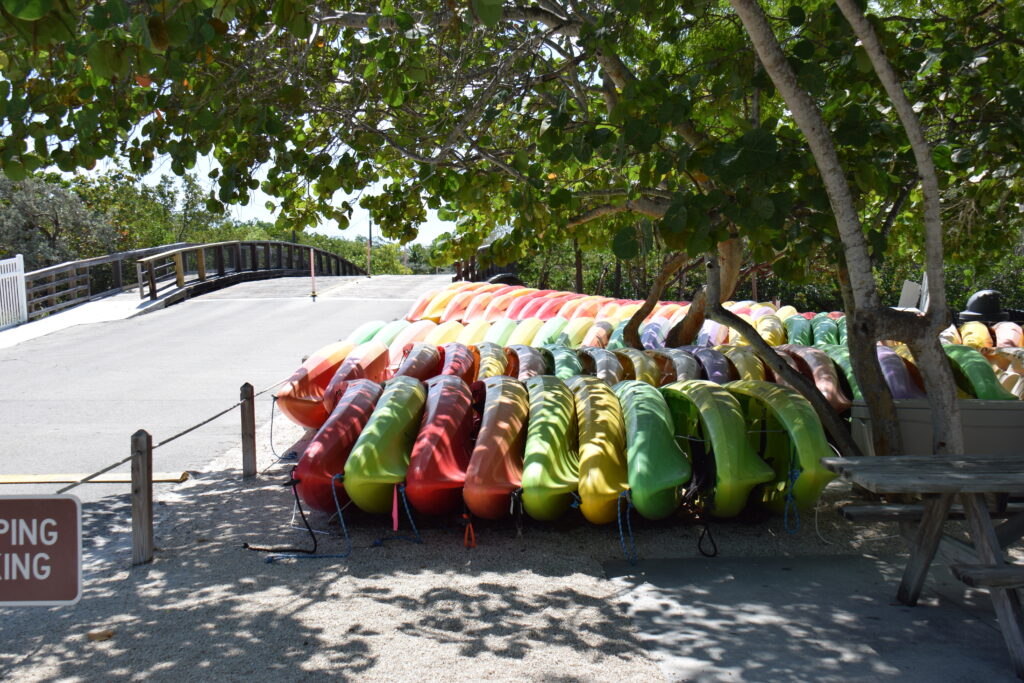
The John Pennekamp Coral Reef State Park offers activities including kayaking, snorkeling, and even an aquarium.
©dlsdds/Shutterstock.com
There are many ways to see and experience all of the adventure, beauty, and wonder of John Pennekamp Coral Reef State Park! On land, you can enjoy a stroll along one of the park’s many short trails or enjoy a picnic by the beach. There is also a Visitor Center with a 30,000-glass saltwater aquarium and a theater with nature shows.
Snorkeling and scuba diving are some of the most popular activities in the park. These allow you to get up close and personal with much of the wildlife here. However, if you’re not ready to take a dip in the ocean, you can also kayak and canoe through the park’s waters or take a tour on one of the many glass-bottom boats.
If you decide to take the plunge and dive, you could also check out the famous “Christ of the Abyss.” Standing around 25 feet below the water’s surface at the Key Largo Dry Rocks Reef, the 8.5 feet tall, 4,000-pound statue of Jesus Christ stands quietly amid the park’s marine life. The statue is a casting of the Cristo Degli Abissi that stands in the Mediterranean Sea near Genoa, Italy. Although separated by miles of land and sea, the two underwater statues stand facing one another.
The photo featured at the top of this post is © Felix Mizioznikov/Shutterstock.com
FAQs (Frequently Asked Questions)
Are there crocodiles at John Pennekamp Coral Reef State Park?
Yes, there are American crocodiles here. They are not commonly seen, but often do spend time along the shore and especially in the mangrove areas.
Are there alligators at John Pennekamp Coral Reef State Park?
Alligators spend most of their time in freshwater environments, but they have been known to venture into saltwater as well on occasion. However, it is not very likely that you will see an alligator at the park.
Are there sharks at John Pennekamp Coral Reef State Park?
Yes, there are several different types of sharks here. The most commonly seen are nurse sharks, which are not aggressive toward humans.
Is the water clear at John Pennekamp Coral Reef State Park?
In some of the offshore areas, the water is very clear. However, water closer to shore doesn’t offer the same stunning experience. If you come to the park for just a short visit, you likely won’t be able to spot clear water or go snorkeling at the reef.
To really experience the beauty of this underwater park, you should dedicate a full day or more if you want to do more water-related activities like swimming, snorkeling, and seeing coral.
Are there good beaches at John Pennekamp Coral Reef State Park?
The beaches of Key Large are quite pretty, but they are not the tropical Caribbean-type beaches that people often imagine. These beaches have harder sand with rocks and mangroves. The water is typically calm at the beaches here, but it is not as clear as the waters surrounding the coral reefs further from the beaches.
Can you snorkel on your own at John Pennekamp State Park?
Yes, although the guided underwater tours offer the best experience at John Pennekamp State Park. However, if you just want to try out snorkeling and familiarize yourself with the sport, then shore snorkeling from the beach here can be great for beginners. The water near the beach doesn’t have the best views of the park, but it can still be a lot of fun.
Thank you for reading! Have some feedback for us? Contact the AZ Animals editorial team.






